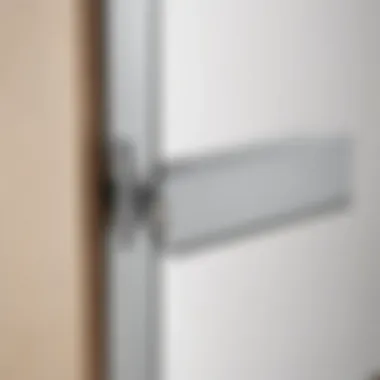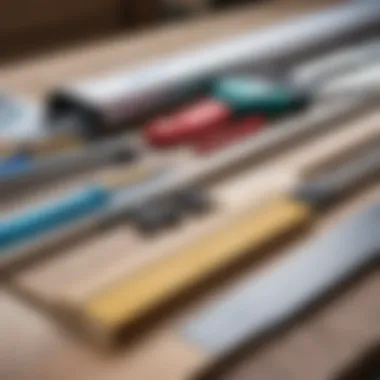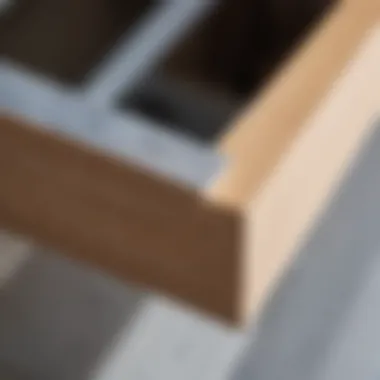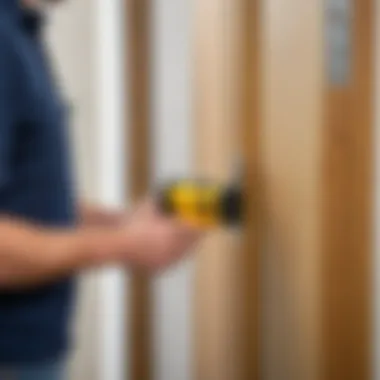Reinforcing Interior Door Frames for Durability


Intro
A door frame is a critical component in the structural integrity of an interior door. Over time, normal wear and tear can compromise its strength, leading to issues like misalignment, gaps, and even security concerns. Strengthening the door frame not only prolongs the lifespan of the door but also enhances the overall security of your home. This article is a detailed guide for those who wish to reinforce their interior door frames. We will explore various methods and materials, outline practical steps and tips, and discuss essential safety measures. Let us delve into the project design and planning phase, giving you a solid foundation for your DIY journey.
Проектирование и планирование
Как выбрать проект для DIY
Selecting the right project for reinforcing your door frame requires careful consideration. Begin by assessing the current condition of your door frames. Look for signs of damage such as cracks, warping, or splitting wood. Based on your evaluation, you can choose a project that targets specific weaknesses. This may include reinforcing existing frames with additional support, or completely replacing them if they are beyond repair.
Here are key projects to consider:
- Bracing and Reinforcement: Add metal brackets or wooden braces for extra support.
- Frame Replacement: For severely damaged frames, consider complete replacement with new sturdy materials.
- Weatherproofing: If applicable, enhance the door frame to resist moisture and prevent warping.
Оценка времени и ресурсов
Time is an essential resource in any DIY project. Assess how long you can dedicate to this task. Depending on the complexity of your chosen project, this can vary. Simple reinforcements may only take a few hours, while full replacements could require a full day or more.
Resources needed can include:
- Tools like drills, screws, and saws
- Materials such as wood, metal brackets, and sealants
- Safety gear, including goggles and gloves
Consider creating a timeline that includes project milestones. This will help keep your work organized and manageable, ensuring you stay on track.
Выбор материалов
Типы материалов для различных проектов
The choice of materials plays a pivotal role in the success of strengthening door frames. You may select from several options based on your project needs.
For simple reinforcements, consider:
- Plywood: Offers good strength and durability.
- Softwood: Easy to work with and cost-effective.
For more extensive repairs or replacements, think about:
- Hardwood: Provides superior strength and longevity.
- Metal Brackets: Used for additional structural support.
Советы по покупке и экономии
When purchasing materials, look for high-quality products to ensure durability. Local hardware stores may have sales or discounts. Online marketplaces can provide competitive pricing but verify the quality through reviews.
To save on costs:
- Buy in bulk where possible to reduce per-unit prices.
- Check for salvaged materials, which can be effective and economical options.
Understanding Door Frame Composition
Understanding the composition of door frames is essential for anyone looking to strengthen their interior doors. The door frame is not just a static structure. It plays a critical role in ensuring the durability and functionality of the door itself. By knowing the types of materials and their properties, one can make informed decisions on reinforcement strategies. This knowledge will aid in addressing issues that may arise due to environmental factors, wear and tear, or improper installations.
Material Types of Door Frames
Wood
Wood is a traditional choice for door frames, offering aesthetic appeal and good insulation. One of its key characteristics is its natural beauty; it can be stained or painted to complement various decor styles. The unique feature of wood is its ability to blend seamlessly into the home’s interior. However, wood can be susceptible to humidity and insects, which can be a disadvantage in certain environments.
Metal
Metal frames, commonly made from steel or aluminum, provide a high level of strength and security. The primary characteristic of metal is its durability, making it an ideal choice for high-traffic areas or commercial spaces. Metal frames do not warp or swell like wood, which is a notable advantage. On the downside, metal may not offer the same aesthetic warmth as wood, and can be prone to rust if not properly treated.
Composite
Composite materials combine various elements to create a strong and stable door frame. The main benefit of composite is its resistance to weather-related issues; they are less likely to warp or crack. Additionally, composite materials can be designed to mimic the appearance of wood but often at a lower cost. However, the long-term durability of composites can vary, and they may not be as repairable as solid wood options.


Structure of a Typical Door Frame
Components
The components of a door frame consist mainly of the header, jambs, and sill. Understanding these parts is crucial for assessing the frame's integrity. The key characteristic is that each component serves a specific function in supporting the door. For instance, the header bears the weight above the door, while the jambs secure the door itself. If any component is compromised, the overall structure of the door frame can weaken, making it vital for repairs or reinforcements.
Design Variations
Design variations in door frames can significantly impact their performance. Common types include square, arch-top, and patterned styles. The advantage of these variations is that they can fit unique aesthetics and functional needs. A square design may create a contemporary look, while an arch-top can provide a more classical appearance. However, the choice of design can influence installation methods and the type of reinforcement required.
Common Issues with Door Frames
Understanding common issues with door frames is crucial for anyone concerned with interior door integrity. Addressing these problems not only enhances the longevity of the door but also ensures safety and aesthetic value in a space. Recognizing signs of wear and environmental influences are fundamental parts of this article.
Signs of Weakness
Identifying signs of weakness in door frames can prevent larger, more costly issues down the line. The problems may range from alignment issues to physical damage, all of which could compromise security and functionality. Common signs include:
Misalignment
Misalignment occurs when a door does not sit properly in its frame. This happens when the frame shifts, often due to structural changes in the building. Misalignment can lead to problems such as drafts and difficulty closing the door. One key characteristic of misalignment is the door rubbing against the frame, causing further wear and tear over time. This issue is critical as it affects not only functionality but also energy efficiency in the home. Addressing misalignment, therefore, becomes a beneficial step towards reinforcing a door's frame.
Cracks and Gaps
Cracks and gaps in the frame can indicate significant weaknesses. These flaws often arise from aging materials or extreme temperature changes. The primary characteristic of cracks is their ability to expand, leading to more severe structural issues. Recognizing and addressing these gaps is vital, as they can allow pests and drafts to enter the home. While cracks may not seem severe at first glance, ignoring them can lead to extensive damage, making it essential to consider repair or reinforcement options.
Swelling
Swelling of the door frame is generally caused by excessive moisture. Wood, being a natural material, absorbs humidity, which causes it to expand. This phenomenon can lead to doors sticking and becoming difficult to operate. Assessing the condition of the frame regularly is beneficial, as swelling can worsen over time. Unique to swelling is the necessity of controlling humidity levels in the home to prevent this issue. The advantages of addressing swelling include improved functionality and extended lifespan of the door.
Environmental Factors
Environmental factors play a significant role in the durability of door frames. Moisture levels, temperature fluctuations, and weather conditions can severely impact the integrity of interior doors. Understanding these environmental effects is critical for effective maintenance.
Humidity Effects
Humidity can affect door frames by causing expansion or deterioration of materials. High humidity levels lead to increased moisture absorption in wooden frames, contributing to swelling and misalignment. A key characteristic of humidity effect is its unpredictability; it can cause immediate issues or develop gradually. Recognizing humidity’s impact is essential in this article, as controlling moisture can prevent long-term damage and costly repairs.
Temperature Changes
Temperature changes can result in material contraction and expansion, leading to warping of door frames. The critical aspect of temperature influence is its dual nature; extremes can exacerbate existing problems. For example, seasonal shifts may create stress on materials, particularly in wood. The unique feature of temperature changes is their inevitability, necessitating proactive measures for maintenance. Understanding and mitigating these effects can significantly enhance the durability of door frames.
Addressing common issues related to door frames is a prerequisite for any effective reinforcement strategy. Ignoring them can lead to increased repair costs and diminished safety.
Materials for Strengthening Door Frames
Strengthening door frames is essential for maintaining the durability and functionality of interior doors. Selecting the right materials can significantly enhance a door frame's strength and resilience. It involves understanding various hardware options and the type of wood used. The right choices address common issues such as sagging, warping, or misalignment.
Reinforcement Hardware
Braces and Straps
Braces and straps play a crucial role in strengthening door frames. These components provide additional support that can prevent bowing and warping over time. One of the key characteristics of braces and straps is their ability to distribute weight evenly across the frame. This minimizes the stress on any one point, reducing the risk of failure.
Braces are often triangular in shape, which allows them to hold significant weight while occupying minimal space. Straps, on the other hand, can be straight and long, running along the length of the frame. Both options are popular because they do not require extensive alterations to existing structures.
The main advantage of braces and straps is their effectiveness in enhancing stability. However, a disadvantage could be the aesthetic impact; depending on the use, they may not blend well with decor. Evaluating the design plays an important role in making this choice.
Additional Hinges
Additional hinges are another method to fortify door frames. They help to distribute the door’s weight more evenly, reducing strain on each hinge and the frame itself. The main characteristic of additional hinges is that they can fall into standard or heavy-duty types. Standard hinges are sufficient for lighter doors, while heavy-duty options are necessary for those weighing more.
Adding hinges can significantly improve the overall functionality of a door. They allow doors to open and close smoothly, minimizing wear and tear over time. The trade-off, however, could be the potential to create installation complexity. Understanding the nuances of hinge placement is crucial.
Choosing the Right Wood


Hardwood vs. Softwood
When selecting wood for strengthening door frames, one must consider the differences between hardwood and softwood. Hardwood, derived from deciduous trees, is known for its density and durability. Softwood comes from coniferous trees and typically has a lighter weight. Both types serve specific purposes in structural integrity.
The main advantage of hardwood is its resistance to denting and wear, making it a popular choice for high-traffic areas. However, it can be more expensive than softwood. On the other hand, softwood is easier to work with and is often more affordable, but it may not stand up to stress as well as hardwood. It is vital to choose according to the application and setting.
Treatment and Preservation
Treatment and preservation of wood can drastically enhance its lifespan. These processes protect against moisture, pests, and decay, which are common issues affecting door frames. Treatment options may include sealing, painting, or applying protective coatings.
Using treated wood offers many benefits, including increased resistance to environmental factors. It ensures that the wood maintains its strength during temperature and humidity fluctuations. The unique marketing point for treated wood is long-term durability. However, potential downsides could be the need for ongoing maintenance to maintain its protective qualities. Regular checks for wear are important to maximize the effectiveness of treatment.
"Selecting the right materials and understanding their characteristics can lead to a more resilient door frame, ultimately extending the life of your interior doors."
Tools Required for the Project
When embarking on a project to strengthen the door frame of interior doors, the selection of tools is paramount. The right tools not only facilitate the work but also enhance the effectiveness of each step. Using appropriate tools can lead to better results, minimize errors, and ensure safety. Here are key tools necessary for the undertaking.
Basic Tools List
Hammer
A hammer is an essential tool for this project. It helps drive nails and fasteners securely into the wood. The primary characteristic of a hammer is its striking force, which aids in ensuring strong connections within the frame. A claw hammer, commonly used, is particularly effective due to its dual purpose.
This tool is popular among DIY enthusiasts because it is easy to handle and versatile in application. One unique feature of the claw hammer is its ability to remove nails, which adds to its utility during repairs. An advantage of using a good quality hammer is the precision in striking, helping prevent damage to the wood. However, improper use can lead to dents or splinters, hence caution is advised.
Screwdriver
The screwdriver is another critical tool in reinforcing door frames. It serves the important function of fastening screws, which hold components together strongly. The key characteristic lies in the various types available, such as flathead and Phillips screwdrivers. Each type fits different screw designs, allowing for flexibility in choice.
This tool is favored for its simplicity and effectiveness in providing stability to the frame. A unique benefit of screwdrivers is their capability to be used in tight spaces where other tools may not fit. However, over-tightening screws can lead to stripping, which is a considerable drawback, thus balance is necessary during use.
Drill
A drill has significant importance in the strengthening process. It is used for making precise holes for screws or dowels, enhancing the structural integrity of the door frame. The vital characteristic of a drill includes its adjustable speed settings, which offer control over various tasks such as creating pilot holes or driving screws.
This choice is beneficial due to its efficiency. A power drill can save considerable time and effort compared to manual alternatives. Its unique feature, a variety of drill bits, allows users to tackle different materials or sizes. However, improper handling can cause damage to the wood or accidents if safety precautions are not followed.
Safety Equipment
Safety measures are crucial when working with tools and materials. The right protective gear is necessary to prevent injuries or accidents during the reinforcement process.
Goggles
Wearing goggles is critical to shield your eyes from debris or dust that may arise during the project. The main characteristic of safety goggles is the snug fit, which prevents particles from entering. This equipment is especially beneficial as it protects the delicate eye area from potential injuries while handling tools.
A unique feature of many goggles is their anti-fog lenses, ensuring clarity while working. The main advantage of using goggles is the added layer of security; however, they can feel uncomfortable for prolonged use, so ensuring a comfortable fit is essential.
Gloves
Using gloves during this project cannot be overlooked. They provide protection against sharp tools and rough edges that may cause cuts and scrapes. The key characteristic of gloves lies in materials like leather or synthetic fabrics, which offer both flexibility and durability.
Gloves are popular for their ability to improve grip, making it easier to handle tools securely. A notable feature is their varying thickness, allowing the user to choose based on the task's demands. However, too thick gloves can reduce tactile sensitivity, so it is important to balance protection with the need for a good feel.
Remember, proper tools and safety gear can significantly influence the success of your door frame reinforcement project. Don’t skimp on preparation.
Step-by-Step Guide to Reinforcing
Preparation Stage
Assessing the Current Frame
Assessing the current frame is an essential first step. This process involves checking for structural weaknesses. Homeowners should look for misalignment, cracks, or signs of wear. Identifying these issues early helps determine the extent of reinforcement needed.
One key characteristic of this assessment is its thoroughness. It is a beneficial choice since it lays the groundwork for effective repairs. The unique feature of assessing the current frame is its ability to inform the homeowner of necessary actions. Understanding the existing condition saves time and effort during the reinforcement process.


Gathering Materials
Gathering materials is a vital step in the preparation stage. Having the right components ready simplifies the reinforcement process. It enables quick execution once the assessment is complete. This ensures that any issues can be addressed promptly without delay.
One key characteristic of gathering materials is its focus on quality. Using high-quality materials makes the reinforcement more effective. A unique feature of this stage is the ability to customize the materials used based on the specific needs of the door frame. This ensures that the reinforcement will be durable and long-lasting, though it may require additional research to find the best options.
Strengthening Process
Installing Reinforcement Braces
Installing reinforcement braces is a crucial step in enhancing the door frame's stability. This involves placing metal or wooden braces in strategic locations. Proper installation can significantly increase the frame's load-bearing capacity. One key characteristic of this process is that it directly contributes to the overall structural strength.
The installation of braces is a popular choice because it is effective and relatively straightforward. A unique aspect of installing reinforcement braces is the variety of techniques available. However, improper installation can lead to ineffective reinforcement, so careful attention to detail is necessary.
Replacing Damaged Parts
Replacing damaged parts is often necessary when the current frame shows significant wear. This step involves identifying and removing compromised sections. New materials must fit seamlessly into the existing structure. This will restore the frame’s strength and functionality.
The key characteristic of replacing damaged parts is the restoration it provides. It brings the frame back to its original integrity or better. One unique feature is its preventive nature; proactive replacements can extend the life of the door frame. However, it is important to select compatible replacement parts appropriately, as mismatched components can lead to future issues.
Maintaining Strengthened Door Frames
Maintaining a strengthened door frame is essential for the longevity and effectiveness of your interior doors. Over time, wear and environmental factors can impact the structural integrity of the frame. Regular maintenance not only helps sustain the improvements made during the initial reinforcement process but also ensures that your doors continue to function properly and provide security. The benefits of maintaining the door frame include enhanced durability, increased resistance to damages, and avoidance of costly repairs in the future.
Regular Inspections
Checking for Signs of Wear
The act of regularly checking for signs of wear is critical in maintaining door frames. This involves looking for visual markers such as chipping paint, misaligned hinges, and gaps in the frame. By identifying these issues early, you can take necessary action before they escalate into larger problems. A key characteristic of checking for wear is its straightforward nature—anyone can conduct a simple inspection without needing advanced skills. Furthermore, it is a beneficial practice because it encourages vigilance in maintaining the performance and appearance of your door frames.
Unique features of this process include assessing both the material condition of the frame and its alignment. Regular inspections can save time and resources, providing you a clear picture of when and where repairs are needed.
Addressing Minor Issues
Addressing minor issues in door frames can greatly extend the lifespan of your installations. Small problems such as loose screws or minor cracks can often be fixed quickly. Neglecting these minor defects can lead to larger, more complex challenges down the road. The key characteristic of this maintenance task is its accessibility; even those with limited DIY experience can often tackle these fixes. This offers an avenue for homeowners to take proactive measures in home maintenance.
The unique feature of addressing these minor issues is the ease of access to tools and resources. Many repairs require only common tools like screwdrivers or wood glue. The advantage is to save both time and money, ensuring your door frames remain in optimal condition without large expenses.
Seasonal Maintenance Tips
Weatherproofing Techniques
Weatherproofing techniques point to a range of methods that protect door frames from the elements. This is particularly important in regions with extreme temperatures or heavy precipitation. Key methods can include applying weatherstripping, sealing gaps, or adding a protective coat. Such measures not only enhance the aesthetic value of your frames but also reduce energy loss in your home.
A unique aspect of these techniques is their ability to create an air-tight seal, preventing drafts and moisture from entering. While some weatherproofing methods can be simple, others may require a bit more finesse. However, the advantages far outweigh the disadvantages, especially when it comes to preserving indoor comfort and energy efficiency.
Adjusting for Humidity
Adjusting for humidity is another essential practice in door frame maintenance. Overly humid environments can lead wood to swell, creating misalignment in the frames. Managing humidity levels relates directly to the stability of wood components. A major characteristic of this practice is the use of dehumidifiers or proper ventilation to balance moisture levels.
Unique features of humidity adjustment include the installation of proper insulation or even humidity-sensitive materials that counteract swelling. The advantages include long-term stability of your doors, while the main disadvantage could be the initial investment in equipment. However, the benefits of avoiding damage make it a worthwhile consideration.
"Regular maintenance of door frames not only preserves their functionality but also enhances the overall beauty of your interior."
Adhering to these guidelines on maintaining strengthened door frames ensures that your efforts in reinforcement pay off in the long term. Regular inspections and seasonal tips will equip you to tackle minor problems before they grow, thus saving you time, effort, and money.
The End
This article highlighted several key elements essential for reinforcing door frames. First, we examined the composition of door frames, identifying different material types and typical structures. Understanding these components is fundamental as it influences how one approaches the reinforcement process.
Moreover, recognizing common issues, such as cracks, misalignment, and environmental factors like humidity, equips homeowners with the awareness needed to act promptly. The methods and materials for strengthening door frames play an equally significant role. From hardware reinforcements to choosing suitable materials, each choice impacts durability and functionality.
The step-by-step guide provided practical instructions to carry out these improvements, emphasizing the need for proper tools and precautions, ensuring safety during the project. Furthermore, maintaining the integrity of your door frames through regular inspections and seasonal maintenance can significantly prolong their lifespan and stability.
Summary of Key Points
- Importance of Stability: A strong door frame contributes to the overall durability and functionality of doors.
- Material Understanding: Different frame materials impact the reinforcement techniques used.
- Identification of Issues: Awareness of common problems is essential for proactive maintenance.
- Use of Proper Tools & Techniques: Following a methodical reinforcement process is vital for achieving desired results.
- Ongoing Maintenance: Regular care can prevent minor issues from escalating into major problems.
Final Thoughts
Remember, a well-maintained door frame reflects care and attention to detail in home improvement, reinforcing its importance in any renovation project.







